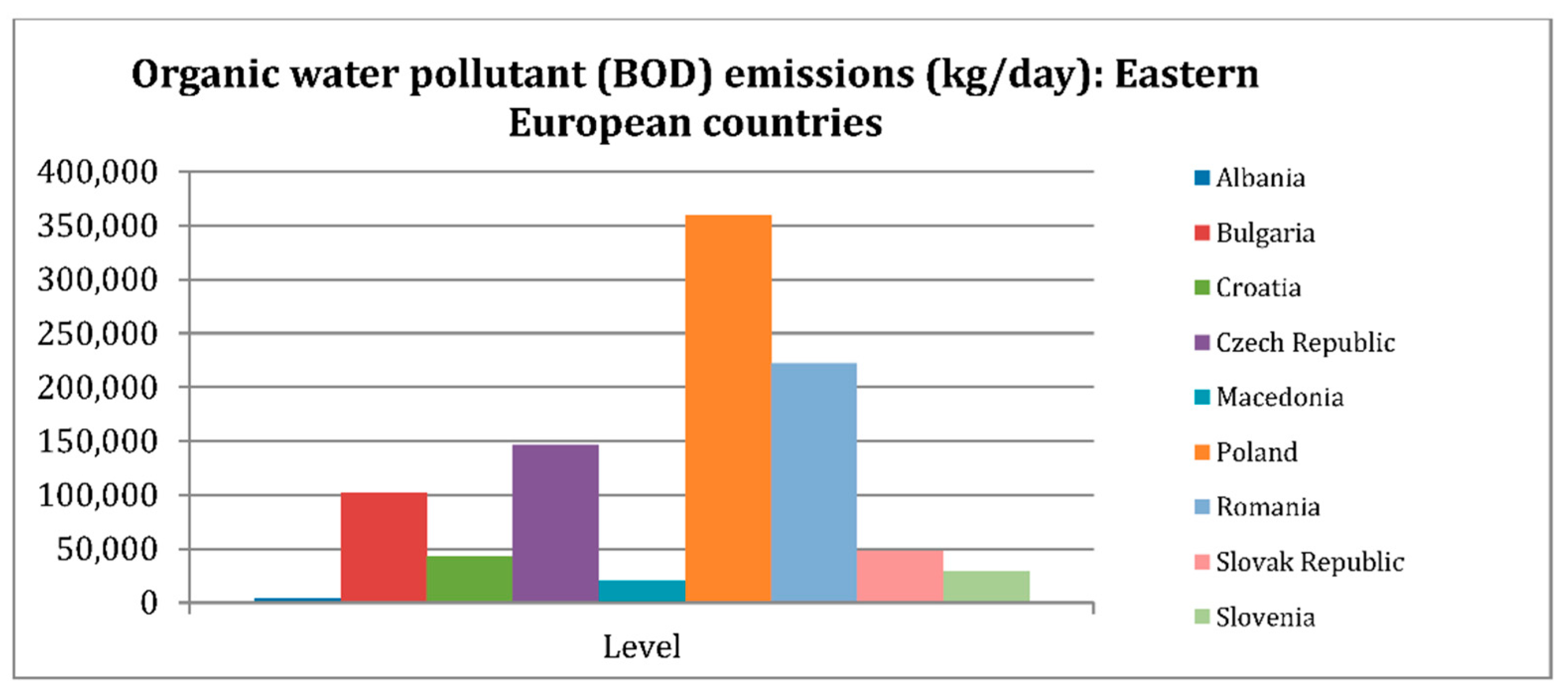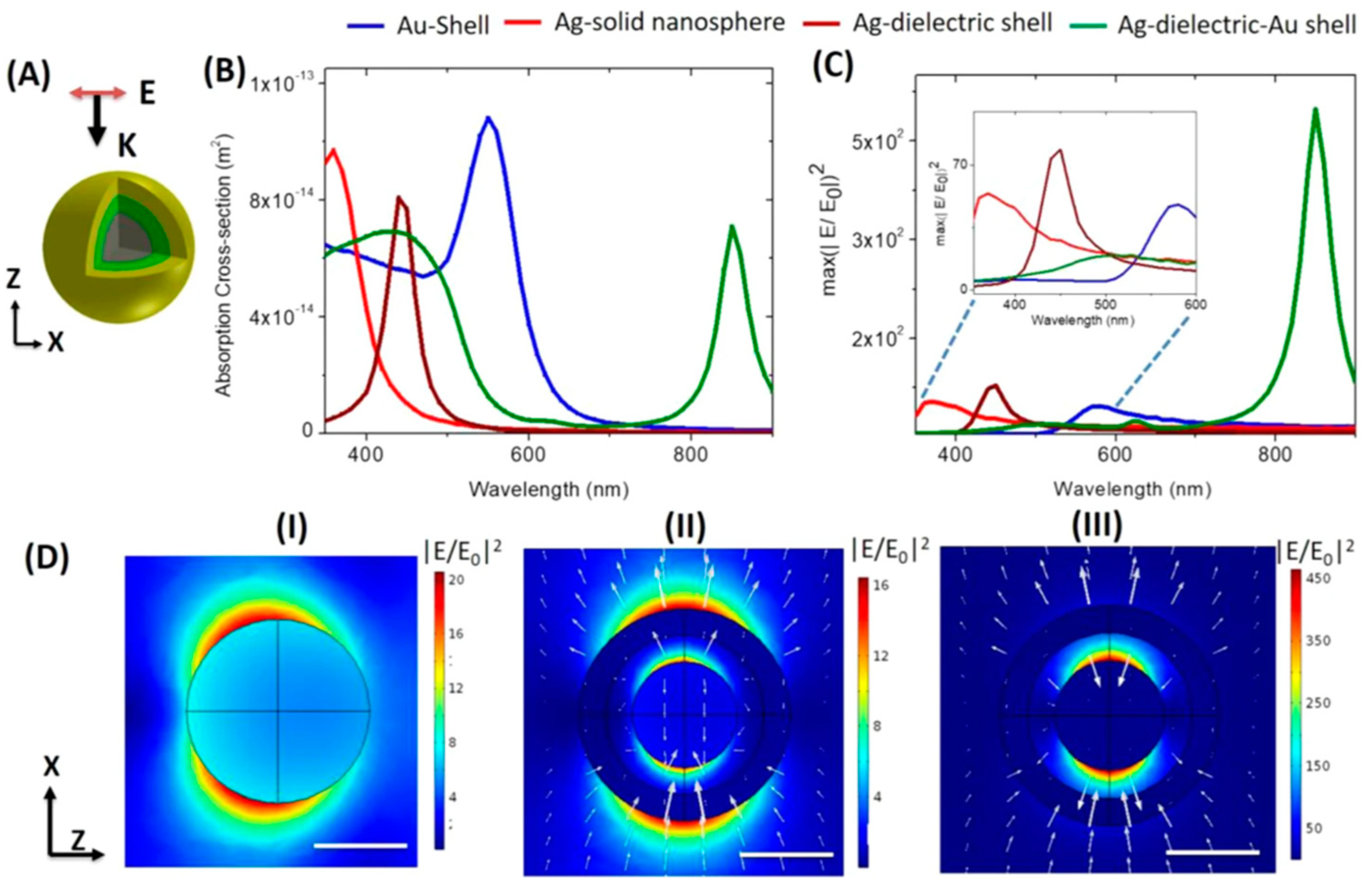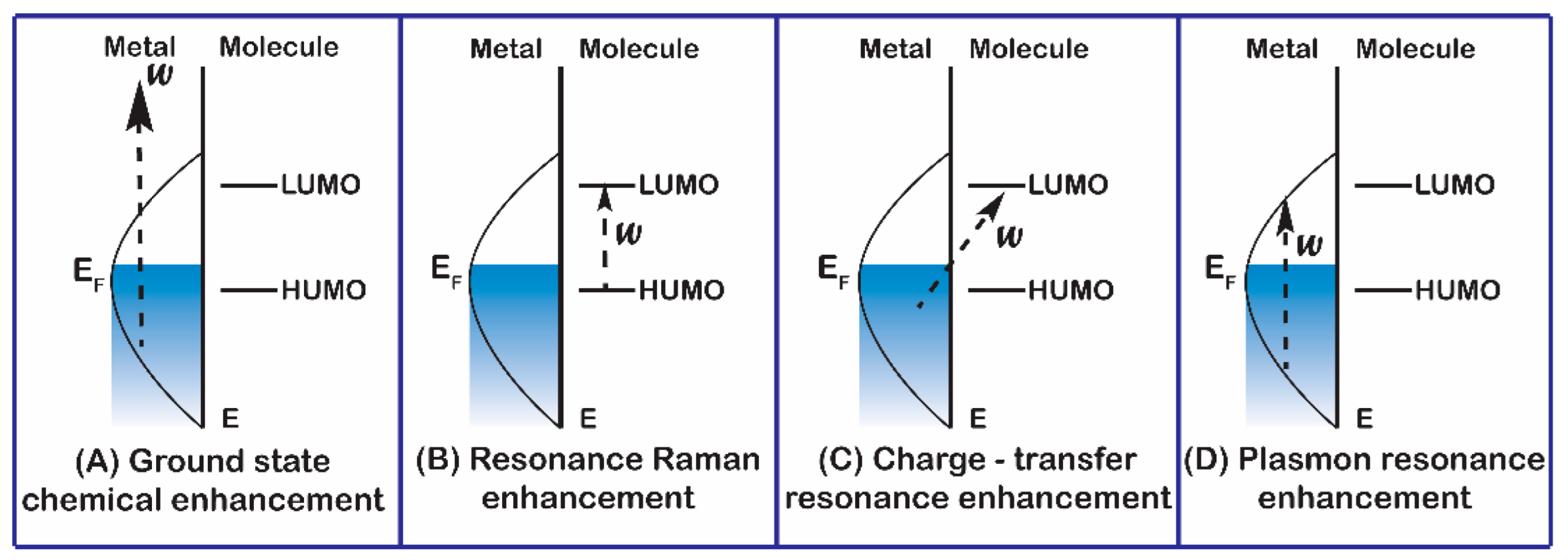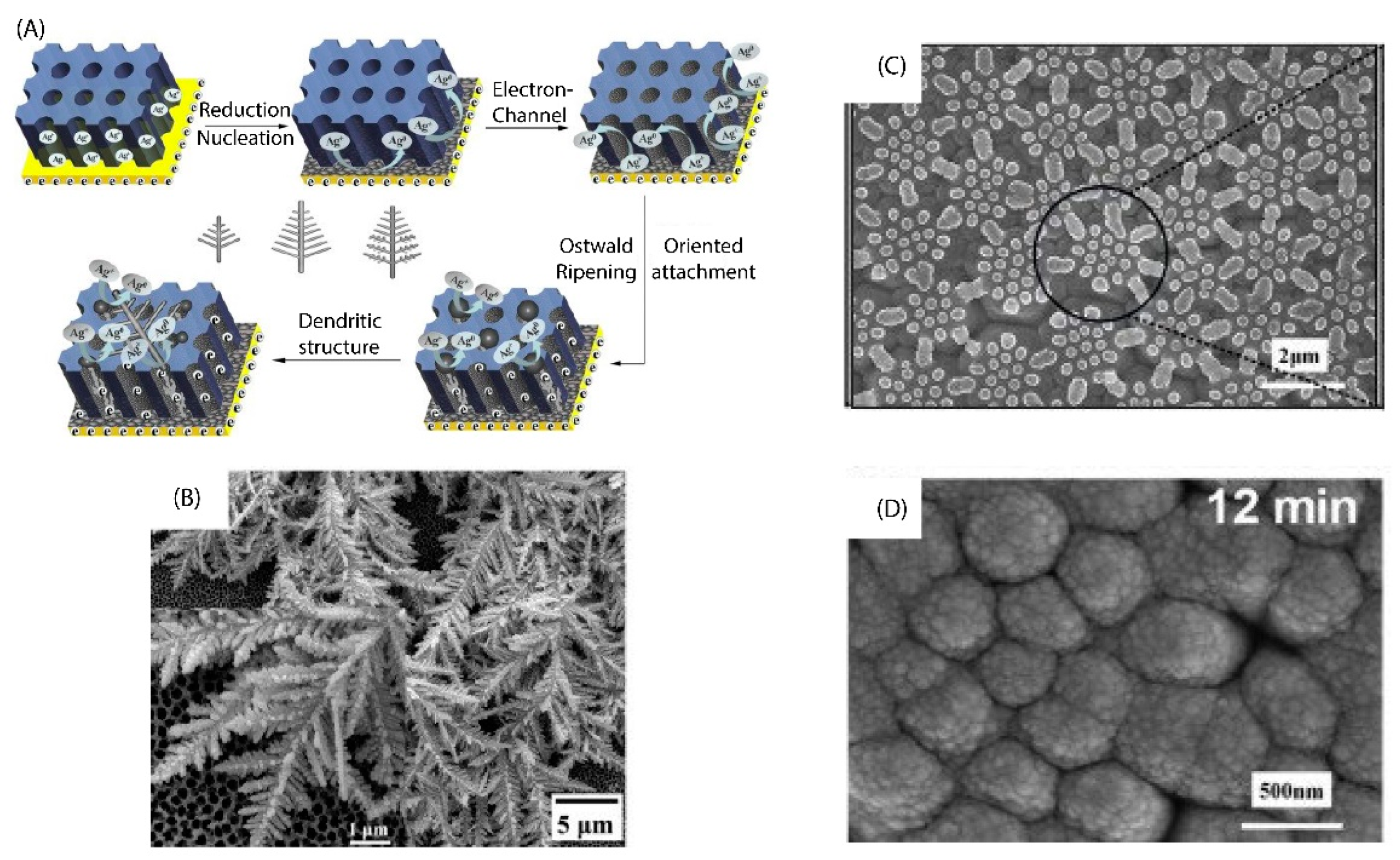Sensors for Detection of the Synthetic Dye Rhodamine in Environmental Monitoring Based on SERS
Abstract
:1. Introduction
2. The Process of Developing the Material Structure of the Substrate by the Electromagnetic (EM) Enhancement Mechanism
2.1. SERS Is Based on the Homogeneous Material
2.2. SERS Is Based on the Heterogeneous Material
3. Developing the Material Structure of the Substrate by the Chemical Mechanism (CM)
4. Influence of Substrate Morphology and Material on SERS Application
5. SERS Approaches to Rhodamine Detection for Food Applications
6. Conclusions
Author Contributions
Funding
Data Availability Statement
Acknowledgments
Conflicts of Interest
References
- Robinson, T.; McMullan, G.; Marchant, R.; Nigam, P. Remediation of Dyes in Textile Effluent: A Critical Review on Current Treatment Technologies with a Proposed Alternative. Bioresour. Technol. 2001, 77, 247–255. [Google Scholar] [CrossRef]
- How Sustainable Dyeing Is Changing the Textile Industry-PCIAW®. Available online: https://pciaw.org/how-sustainable-dyeing-is-changing-the-textile-industry (accessed on 23 September 2022).
- Paraschiv, D.; Tudor, C.; Petrariu, R. The Textile Industry and Sustainable Development: A Holt–Winters Forecasting Investigation for the Eastern European Area. Sustainability 2015, 7, 1280–1291. [Google Scholar] [CrossRef] [Green Version]
- Anh, N.T.T.; Duc, L.M.; Chieu, T.D. The Evolution of Vietnamese Industry. Manuf. Transform. 2016, 235–256. [Google Scholar] [CrossRef] [Green Version]
- Dinh, H.T. Light Manufacturing in Vietnam: Creating Jobs and Prosperity in a Middle-Income Economy; World Bank Publications: Washington, DC, USA, 2014. [Google Scholar] [CrossRef]
- Rodríguez Couto, S. Dye Removal by Immobilised Fungi. Biotechnol. Adv. 2009, 27, 227–235. [Google Scholar] [CrossRef] [PubMed]
- Wijetunga, S.; Li, X.F.; Jian, C. Effect of Organic Load on Decolourization of Textile Wastewater Containing Acid Dyes in Upflow Anaerobic Sludge Blanket Reactor. J. Hazard. Mater. 2010, 177, 792–798. [Google Scholar] [CrossRef] [PubMed]
- Sulistina, D.R.; Martini, S. The Effect of Rhodamine B on the Cerebellum and Brainstem Tissue of Rattus Norvegicus. J. Public Health Res. 2020, 9, 1812. [Google Scholar] [CrossRef]
- Al-Tohamy, R.; Ali, S.S.; Li, F.; Okasha, K.M.; Mahmoud, Y.A.G.; Elsamahy, T.; Jiao, H.; Fu, Y.; Sun, J. A Critical Review on the Treatment of Dye-Containing Wastewater: Ecotoxicological and Health Concerns of Textile Dyes and Possible Remediation Approaches for Environmental Safety. Ecotoxicol. Environ. Saf. 2022, 231, 113160. [Google Scholar] [CrossRef]
- Qi, P.; Lin, Z.; Li, J.; Wang, C.; Meng, W.; Hong, H.; Zhang, X. Development of a Rapid, Simple and Sensitive HPLC-FLD Method for Determination of Rhodamine B in Chili-Containing Products. Food Chem. 2014, 164, 98–103. [Google Scholar] [CrossRef]
- Wang, T.X.; Zhou, L.Y.; Zhang, X.Y.; Jiao, H.X. Analysis of Rhodamine B in Chinese Wolfberry from Market Sale by HPLC. Adv. Mater. Res. 2014, 1010–1012, 826–829. [Google Scholar] [CrossRef]
- Özkantar, N.; Soylak, M.; Tüzen, M. Spectrophotometric Detection of Rhodamine B in Tap Water, Lipstick, Rouge, and Nail Polish Samples after Supramolecular Solvent Microextraction. Turk. J. Chem. 2017, 41, 987–994. [Google Scholar] [CrossRef]
- Cheah, P.W.; Heng, M.P.; Izati, A.; Ng, C.H.; Tan, K.W. Rhodamine B Conjugate for Rapid Colorimetric and Fluorimetric Detection of Aluminium and Tin Ions and Its Application in Aqueous Media. Inorg. Chim. Acta 2020, 512, 119901. [Google Scholar] [CrossRef]
- Wang, J.; Shen, X.; Zhong, P.; Li, Z.; Tang, Q.; Huang, X.; Zherdev, A.V.; Dzantiev, B.B.; Eremin, S.A.; Xiao, Z.; et al. Heterologous Immunoassay Strategy for Enhancing Detection Sensitivity of Banned Dye Rhodamine B in Fraudulent Food. Chem. Biol. Technol. Agric. 2021, 8, 17. [Google Scholar] [CrossRef]
- Zhang, J.; Zhang, L.; Wang, W.; Chen, Z. Sensitive Electrochemical Determination of Rhodamine B Based on a Silica-Pillared Zirconium Phosphate/Nafion Composite Modified Glassy Carbon Electrode. J. AOAC Int. 2016, 99, 760–765. [Google Scholar] [CrossRef] [PubMed]
- Wang, J.; Qiu, C.; Mu, X.; Pang, H.; Chen, X.; Liu, D. Ultrasensitive SERS Detection of Rhodamine 6G and P-Nitrophenol Based on Electrochemically Roughened Nano-Au Film. Talanta 2020, 210, 120631. [Google Scholar] [CrossRef]
- Sharma, H.S.S.; Carmichael, E.; McCall, D. Fabrication of SERS Substrate for the Detection of Rhodamine 6G, Glyphosate, Melamine and Salicylic Acid. Vib. Spectrosc. 2016, 83, 159–169. [Google Scholar] [CrossRef]
- Zhang, Y.; Zong, H.; Zong, C.; Tan, Y.; Zhang, M.; Zhan, Y.; Cheng, J.X. Fluorescence-Detected Mid-Infrared Photothermal Microscopy. J. Am. Chem. Soc. 2021, 143, 11490–11499. [Google Scholar] [CrossRef]
- Munch, G.; McKay, S.; Gussakovsky, E.; Kuzio, B.; Kupriyanov, V.V.; Jilkina, O. Rhodamine 800 as a Near-Infrared Fluorescent Deposition Flow Tracer in Rodent Hearts. Natl. Cent. Biotechnol. Inf. 2011, 16, 065001. [Google Scholar] [CrossRef] [Green Version]
- Disadvantages & Advantages of an HPLC. Available online: https://sciencing.com/disadvantages-advantages-hplc-5911530.html (accessed on 23 September 2022).
- The Principle and Method of ELISA|MBL. Life Sci. -JAPAN-. Available online: https://ruo.mbl.co.jp/bio/e/support/method/elisa.html (accessed on 23 September 2022).
- Fleischmann, M.; Hendra, P.J.; McQuillan, A.J. Raman Spectra of Pyridine Adsorbed at a Silver Electrode. Chem. Phys. Lett. 1974, 26, 163–166. [Google Scholar] [CrossRef]
- Jeanmaire, D.L.; Van Duyne, R.P. Surface Raman Spectroelectrochemistry: Part I. Heterocyclic, Aromatic, and Aliphatic Amines Adsorbed on the Anodized Silver Electrode. J. Electroanal. Chem. Interfacial Electrochem. 1977, 84, 1–20. [Google Scholar] [CrossRef]
- Tang, L.; Li, S.; Han, F.; Liu, L.; Xu, L.; Ma, W.; Kuang, H.; Li, A.; Wang, L.; Xu, C. SERS-Active Au@Ag Nanorod Dimers for Ultrasensitive Dopamine Detection. Biosens. Bioelectron. 2015, 71, 7–12. [Google Scholar] [CrossRef]
- Han, Q.; Zhang, C.; Gao, W.; Han, Z.; Liu, T.; Li, C.; Wang, Z.; He, E.; Zheng, H. Ag-Au Alloy Nanoparticles: Synthesis and in Situ Monitoring SERS of Plasmonic Catalysis. Sensors Actuators B Chem. 2016, 231, 609–614. [Google Scholar] [CrossRef] [Green Version]
- Chen, L.; Chen, B.; Sassa, F.; Hayashi, K. Multi-Layer Filter Structure for Molecular Selective SERS Gas Sensor. In Proceedings of the 2019 IEEE SENSORS, Montreal, QC, Canada, 27–30 October 2019. [Google Scholar] [CrossRef]
- Rekha, C.R.; Jiji, S.G.; Nayar, V.U.; Gopchandran, K.G. Simultaneous SERS Detection Using Hexagonal Hollow Au-Ag Nanoparticles with near Infrared Plasmon. Vib. Spectrosc. 2021, 114, 103233. [Google Scholar] [CrossRef]
- Zheng, H.; Ni, D.; Yu, Z.; Liang, P.; Chen, H. Fabrication of Flower-like Silver Nanostructures for Rapid Detection of Caffeine Using Surface Enhanced Raman Spectroscopy. Sensors Actuators B Chem. 2016, 231, 423–430. [Google Scholar] [CrossRef] [Green Version]
- Le Ru, E.C.; Etchegoin, P.G. Quantifying SERS Enhancements. MRS Bull. 2013, 38, 631–640. [Google Scholar] [CrossRef]
- Stiles, P.L.; Dieringer, J.A.; Shah, N.C.; Van Duyne, R.P. Surface-Enhanced Raman Spectroscopy. Annu. Rev. Anal. Chem. 2008, 1, 601–626. [Google Scholar] [CrossRef] [Green Version]
- Mayer, K.M.; Hafner, J.H. Localized Surface Plasmon Resonance Sensors. Chem. Rev. 2011, 111, 3828–3857. [Google Scholar] [CrossRef]
- Sepúlveda, B.; Angelomé, P.C.; Lechuga, L.M.; Liz-marzán, L.M. LSPR-Based Nanobiosensors. Nanotoday 2009, 4, 244–251. [Google Scholar] [CrossRef]
- Camden, J.P.; Dieringer, J.A.; Wang, Y.; Masiello, D.J.; Marks, L.D.; Schatz, G.C.; Van Duyne, R.P. Probing the Structure of Single-Molecule Surface-Enhanced Raman Scattering Hot Spots. J. Am. Chem. Soc. 2008, 130, 12616–12617. [Google Scholar] [CrossRef]
- Campion, A.; Kambhampati, P. Surface-Enhanced Raman Scattering. Chem. Soc. Rev. 1998, 27, 241–250. [Google Scholar] [CrossRef]
- Jensen, L.; Aikens, C.M.; Schatz, G.C. Electronic Structure Methods for Studying Surface-Enhanced Raman Scattering. Chem. Soc. Rev. 2008, 37, 1061–1073. [Google Scholar] [CrossRef]
- Le Ru, E.C.; Etchegoin, P.G. Rigorous Justification of the |E|4 Enhancement Factor in Surface Enhanced Raman Spectroscopy. Chem. Phys. Lett. 2006, 423, 63–66. [Google Scholar] [CrossRef]
- Gersten, J.; Nitzan, A. Electromagnetic Theory of Enhanced Raman Scattering by Molecules Adsorbed on Rough Surfaces. J. Chem. Phys. 2008, 73, 3023. [Google Scholar] [CrossRef]
- Murphy, C.J.; Sau, T.K.; Gole, A.M.; Orendorff, C.J.; Gao, J.; Gou, L.; Hunyadi, S.E.; Li, T. Anisotropic Metal Nanoparticles: Synthesis, Assembly, and Optical Applications. J. Phys. Chem. B 2005, 109, 13857–13870. [Google Scholar] [CrossRef]
- Zhang, K.; Zeng, T.; Tan, X.; Wu, W.; Tang, Y.; Zhang, H. A Facile Surface-Enhanced Raman Scattering (SERS) Detection of Rhodamine 6G and Crystal Violet Using Au Nanoparticle Substrates. Appl. Surf. Sci. 2015, 347, 569–573. [Google Scholar] [CrossRef]
- Liang, F.; Jin, D.; Ma, P.; Wang, D.; Yang, Q.; Song, D.; Wang, X. Rapid Determination of Rhodamine B in Chili Powder by Surface-Enhanced Raman Spectroscopy. Anal. Lett. 2015, 48, 1918–1929. [Google Scholar] [CrossRef]
- Bartolowits, M.D.; Xin, M.; Petrov, D.P.; Tague, T.J.; Davisson, V.J. Multimeric Rhodamine Dye-Induced Aggregation of Silver Nanoparticles for Surface-Enhanced Raman Scattering. ACS Omega 2019, 4, 140–145. [Google Scholar] [CrossRef] [Green Version]
- Liu, M.; Xiang, R.; Lee, Y.; Otsuka, K.; Ho, Y.L.; Inoue, T.; Chiashi, S.; Delaunay, J.J.; Maruyama, S. Fabrication, Characterization, and High Temperature Surface Enhanced Raman Spectroscopic Performance of SiO2 Coated Silver Particles. Nanoscale 2018, 10, 5449–5456. [Google Scholar] [CrossRef]
- Pham, T.T.H.; Dien, N.D.; Vu, X.H.; Tran, T.T.; Ca, N.X.; Van Truong, N.; Tan, P.M.; Van, H.T.; Van Do, P. Synthesis and In-Depth Study of the Mechanism of Silver Nanoplate and Nanodecahedra Growth by LED Irradiation for SERS Application. J. Electron. Mater. 2020, 49, 5009–5027. [Google Scholar] [CrossRef]
- Zhang, L.; Li, P.; Luo, L.; Bu, X.; Wang, X.; Zhao, B.; Tian, Y. Sensitive Detection of Rhodamine B in Condiments Using Surface-Enhanced Resonance Raman Scattering (SERRS) Silver Nanowires as Substrate. Appl. Spectrosc. 2017, 71, 2395–2403. [Google Scholar] [CrossRef]
- Kumar, G.; Soni, R.K. Silver Nanocube- and Nanowire-Based SERS Substrates for Ultra-Low Detection of PATP and Thiram Molecules. Plasmonics 2020, 15, 1577–1589. [Google Scholar] [CrossRef]
- Tran Truc Phuong, N.; Xoan Hoang, T.; La Ngoc Tran, N.; Gia Phuc, L.; Phung, V.D.; Kieu Thi Ta, H.; Ngoc Bach, T.; Hoa Thi Tran, N.; The Loan Trinh, K. Rapid and Sensitive Detection of Rhodamine B in Food Using the Plasmonic Silver Nanocube-Based Sensor as SERS Active Substrate. Spectrochim. Acta Part A Mol. Biomol. Spectrosc. 2021, 263, 120179. [Google Scholar] [CrossRef] [PubMed]
- Chen, S.; Liu, B.; Zhang, X.; Mo, Y.; Chen, F.; Shi, H.; Zhang, W.; Hu, C.; Chen, J. Electrochemical Fabrication of Pyramid-Shape Silver Microstructure as Effective and Reusable SERS Substrate. Electrochim. Acta 2018, 274, 242–249. [Google Scholar] [CrossRef]
- Fales, A.M.; Vo-Dinh, T. Silver Embedded Nanostars for SERS with Internal Reference (SENSIR). J. Mater. Chem. C 2015, 3, 7319–7324. [Google Scholar] [CrossRef]
- Riswana Barveen, N.; Wang, T.J.; Chang, Y.H. In-Situ Deposition of Silver Nanoparticles on Silver Nanoflowers for Ultrasensitive and Simultaneous SERS Detection of Organic Pollutants. Microchem. J. 2020, 159, 105520. [Google Scholar] [CrossRef]
- Tong, J.; Xu, Z.; Bian, Y.; Niu, Y.; Zhang, Y.; Wang, Z. Flexible and Smart Fibers Decorated with Ag Nanoflowers for Highly Active Surface-Enhanced Raman Scattering Detection. J. Raman Spectrosc. 2019, 50, 1468–1476. [Google Scholar] [CrossRef]
- Wang, S.; Xu, L.P.; Wen, Y.; Du, H.; Wang, S.; Zhang, X. Space-Confined Fabrication of Silver Nanodendrites and Their Enhanced SERS Activity. Nanoscale 2013, 5, 4284–4290. [Google Scholar] [CrossRef]
- Raoof, J.B.; Ojani, R.; Hasheminejad, E.; Rashid-Nadimi, S. Electrochemical Synthesis of Ag Nanoparticles Supported on Glassy Carbon Electrode by Means of P-Isopropyl Calix[6]Arene Matrix and Its Application for Electrocatalytic Reduction of H2O2. Appl. Surf. Sci. 2012, 258, 2788–2795. [Google Scholar] [CrossRef]
- Khabeeri, O.M.; Al-Thabaiti, S.A.; Khan, Z. Citrus Sinensis Peel Waste Assisted Synthesis of AgNPs: Effect of Surfactant on the Nucleation and Morphology. SN Appl. Sci. 2020, 2, 2038. [Google Scholar] [CrossRef]
- Ye, X.Y.; Zhou, Y.M.; Sun, Y.Q.; Chen, J.; Wang, Z.Q. Preparation and Characterization of Ag/ZnO Composites via a Simple Hydrothermal Route. J. Nanopart. Res. 2008, 11, 1159–1166. [Google Scholar] [CrossRef]
- Torreggiani, A.; Jurasekova, Z.; D’Angelantonio, M.; Tamba, M.; Garcia-Ramos, J.V.; Sanchez-Cortes, S. Fabrication of Ag Nanoparticles by γ-Irradiation: Application to Surface-Enhanced Raman Spectroscopy of Fungicides. Colloids Surfaces A Physicochem. Eng. Asp. 2009, 339, 60–67. [Google Scholar] [CrossRef]
- Krklješ, A.; Nedeljković, J.M.; Kacarevic-Popovic, Z.M. Fabrication of Ag-PVA Hydrogel Nanocomposite by γ-Irradiation. Polym. Bull. 2006, 58, 271–279. [Google Scholar] [CrossRef]
- Stamplecoskie, K.G.; Scaiano, J.C. Light Emitting Diode Irradiation Can Control the Morphology and Optical Properties of Silver Nanoparticles. J. Am. Chem. Soc. 2010, 132, 1825–1827. [Google Scholar] [CrossRef] [PubMed]
- Zhou, H.; Gao, D.; Gao, L. Tunability of Multipolar Plasmon Resonances and Fano Resonances in Bimetallic Nanoshells. Plasmon. 2017, 13, 623–630. [Google Scholar] [CrossRef]
- Paria, D.; Zhang, C.; Barman, I. Towards Rational Design and Optimization of Near-Field Enhancement and Spectral Tunability of Hybrid Core-Shell Plasmonic Nanoprobes. Sci. Rep. 2019, 9, 16071. [Google Scholar] [CrossRef] [PubMed] [Green Version]
- Wu, H.; Li, X.; Xu, J.; Wang, C.; Rong, Z.; Xiao, R.; Wang, S. Study on the SERS Substrate Composed of Au@Ag Core-Shell Nanoparticles Linked to SiO2 Spheres. Inorg. Nano-Met. Chem. 2017, 47, 1283–1289. [Google Scholar] [CrossRef]
- Wei, W.; Xi, Z.; Huang, Q.; Wei, W.; Xi, Z.; Huang, Q. Fabrication of SERS-Active Au@Au@Ag Double Shell Nanoparticles for Low-Abundance Pigment Detection. Chin. J. Chem. Phys. 2021, 34, 197–202. [Google Scholar] [CrossRef]
- Childs, A.; Vinogradova, E.; Ruiz-Zepeda, F.; Velazquez-Salazar, J.J.; Jose-Yacaman, M. Biocompatible Gold/Silver Nanostars for Surface-Enhanced Raman Scattering. J. Raman Spectrosc. 2016, 47, 651–655. [Google Scholar] [CrossRef]
- Kamal, S.; Chowdhury, A.; Chung-Kuang Yang, T. Ultrasensitive SERS Detection of Rhodamine 6G Using a Silver Enriched MOF-Derived CuFe2O4 Microcubes Substrate. Spectrochim. Acta Part A Mol. Biomol. Spectrosc. 2022, 270, 120826. [Google Scholar] [CrossRef]
- Kong, X.K.; Chen, Q.W.; Sun, Z.Y. Enhanced SERS of the Complex Substrate Using Au Supported on Graphene with Pyridine and R6G as the Probe Molecules. Chem. Phys. Lett. 2013, 564, 54–59. [Google Scholar] [CrossRef]
- Wang, T.J.; Huang, Y.T.; Liu, Z.Y.; Barveen, N.R. Photochemical Synthesis of ZnO/Ag Heterogeneous Nanostructure on Chemically Patterned Ferroelectric Crystals for High Performance SERS Detection. J. Alloys Compd. 2020, 864, 158120. [Google Scholar] [CrossRef]
- Wang, Y.; Yang, Y.; Sun, Y.; Quan, B.; Li, Y.; Gu, C.; Li, J. Rapidly Fabricating Large-Scale Plasmonic Silver Nanosphere Arrays with Sub-20 Nm Gap on Si-Pyramids by Inverted Annealing for Highly Sensitive SERS Detection. RSC Adv. 2017, 7, 11578–11584. [Google Scholar] [CrossRef] [Green Version]
- Lee, T.; Kwon, S.; Jung, S.; Lim, H.; Lee, J.J. Macroscopic Ag Nanostructure Array Patterns with High-Density Hotspots for Reliable and Ultra-Sensitive SERS Substrates. Nano Res. 2019, 12, 2554–2558. [Google Scholar] [CrossRef]
- LeRu, E.; Etchegoin, P. Princyples of Surface-Enhacenced Raman Specroscopy: And Related Plasmonic Effects; Elsevier: Amsterdam, The Netherlands, 2008; pp. 121–183. [Google Scholar]
- Zhang, C.Y.; Lu, Y.; Zhao, B.; Hao, Y.W.; Liu, Y.Q. Facile Fabrication of Ag Dendrite-Integrated Anodic Aluminum Oxide Membrane as Effective Three-Dimensional SERS Substrate. Appl. Surf. Sci. 2016, 377, 167–173. [Google Scholar] [CrossRef]
- Cai, J.; Wang, Z.; Wang, M.; Zhang, D. Au Nanoparticle-Grafted Hierarchical Pillars Array Replicated from Diatom as Reliable SERS Substrates. Appl. Surf. Sci. 2021, 541, 148374. [Google Scholar] [CrossRef]
- Li, R.; Li, H.; Pan, S.; Liu, K.; Hu, S.; Pan, L.; Guo, Y.; Wu, S.; Li, X.; Liu, J. Surface-Enhanced Raman Scattering from Rhodamine 6G on Gold-Coated Self-Organized Silicon Nanopyramidal Array. J. Mater. Res. 2013, 28, 3401–3407. [Google Scholar] [CrossRef]
- Zhou, Y.; Yao, H.; Liu, C.; Chen, M.; Zhang, C.; Liu, M.; Wang, J.; Zhang, F.; Yu, J.; Man, B.; et al. High-Performance Flexible Surface-Enhanced Raman Scattering Substrate Based on the Particle-in-Multiscale 3D Structure. Nanophotonics 2021, 10, 4045–4055. [Google Scholar] [CrossRef]
- Gutiérrez, Y.; Losurdo, M.; Prinz, I.; Prinz, A.; Bauer, G.; Bauer, M.; Schmidt, M.M.; Schaller, T. Paving the Way to Industrially Fabricated Disposable and Customizable Surface-Enhanced Raman Scattering Microfluidic Chips for Diagnostic Applications. Adv. Eng. Mater. 2022, 24, 2101365. [Google Scholar] [CrossRef]
- Mao, H.; Qian, C.; Lv, P.; Wu, W. SERS-Active Substrates Based on Metallic Nanocracks on PDMS. In Proceedings of the 2011 6th IEEE International Conference on Nano/Micro Engineered and Molecular Systems, Kaohsiung, Taiwan, 20–23 February 2011; pp. 321–324. [Google Scholar] [CrossRef]
- Dong, J.; Yang, C.; Wu, H.; Wang, Q.; Cao, Y.; Han, Q.; Gao, W.; Wang, Y.; Qi, J.; Sun, M. Two-Dimensional Self-Assembly of Au@Ag Core–Shell Nanocubes with Different Permutations for Ultrasensitive SERS Measurements. ACS Omega 2022, 7, 3312–3323. [Google Scholar] [CrossRef]
- Yue, W.; Yue, W.; Yue, W.; Liu, C.; Liu, C.; Zha, Z.; Liu, R.; Gao, J.; Shafi, M.; Feng, J.; et al. Composite Substrate of Graphene/Ag Nanoparticles Coupled with a Multilayer Film for Surface-Enhanced Raman Scattering Biosensing. Opt. Express 2022, 30, 13226–13237. [Google Scholar] [CrossRef]
- Guo, Y.; Yu, J.; Li, C.; Li, Z.; Pan, J.; Liu, A.; Man, B.; Wu, T.; Xiu, X.; Zhang, C. SERS Substrate Based on the Flexible Hybrid of Polydimethylsiloxane and Silver Colloid Decorated with Silver Nanoparticles. Opt. Express 2018, 26, 21784. [Google Scholar] [CrossRef]
- Bian, L.; Liu, Y.; Zhu, G.; Yan, C.; Zhang, J.; Yuan, A. Ag@CoFe2O4/Fe2O3 Nanorod Arrays on Carbon Fiber Cloth as SERS Substrate and Photo-Fenton Catalyst for Detection and Degradation of R6G. Ceram. Int. 2018, 44, 7580–7587. [Google Scholar] [CrossRef]
- Sun, Y.; Li, W.; Zhao, L.; Li, F.; Xie, Y.; Yao, W.; Liu, W.; Lin, Z. Simultaneous SERS Detection of Illegal Food Additives Rhodamine B and Basic Orange II Based on Au Nanorod-Incorporated Melamine Foam. Food Chem. 2021, 357, 129741. [Google Scholar] [CrossRef] [PubMed]
- Li, X.; Li, M.; Li, J.; Lei, F.; Su, X.; Liu, M.; Li, P.; Tan, X. Synthesis and Characterization of Molecularly Imprinted Polymers with Modified Rosin as a Cross-Linker and Selective SPE-HPLC Detection of Basic Orange II in Foods. Anal. Methods 2014, 6, 6397–6406. [Google Scholar] [CrossRef]







| Substrate | Synthesis/Fabrication | Analytes | Linear Range | EF (Fold) | LOD | Ref |
|---|---|---|---|---|---|---|
| Nano-Au film | Electrochemical | R6G | 10−5–10−9 M | 108 | 10−11 M | [16] |
| Ag NPs solutions | Chemical reduction method | RhB | 0.2–20 µg/L | 1.6 × 107 | 0.08 µg/L | [40] |
| AgNFs @ AgNPs | The one-step solution-phase | R6G | - | 1012 | 10−14 M | [50] |
| ITO/Ag NDs | Electrochemical | R6G | 10−5–10−11 M | 1.3 106 | 10−11 M | [69] |
| Au@Ag NCs | Liquid–liquid self-assembly and evaporation-induced self-assembly methods | R6G | 10−8–10−12 M | 2.2 × 108 | 10−12 M | [75] |
| ZnO/Ag heterogeneous | Hydrothermal, photoreduction | R6G | 10−5–10−8 M | 7 × 108 | <10−8 M | [65] |
| Graphene/Ag NPs on multilayer film | Vacuum thermal evaporation, CVD | R6G | 10−6–10−11 M | 2.8 × 107 | 10 −11 M | [76] |
| Flexible AgNPs/AgNPs-PDMS | Chemical reduction method, dip-coating method | R6G | 10−9–10−13 M | 8.3 × 109 | 10−13 M | [77] |
| CuFe2O4 (Ag-CFO) microtubes | MOF template | R6G | 10−5–10−13 M | 1012 | 10−14 M | |
| Ag@CoFe2O4/Fe2O3 nanorod arrays | Hydrothermal and photochemical reduction process | R6G | 10−8–10−10 M | 1.2 × 108 | 10−10 M | [78] |
Publisher’s Note: MDPI stays neutral with regard to jurisdictional claims in published maps and institutional affiliations. |
© 2022 by the authors. Licensee MDPI, Basel, Switzerland. This article is an open access article distributed under the terms and conditions of the Creative Commons Attribution (CC BY) license (https://creativecommons.org/licenses/by/4.0/).
Share and Cite
Phuong, N.T.T.; Nguyen, T.-A.; Huong, V.T.; Tho, L.H.; Anh, D.T.; Ta, H.K.T.; Huy, T.H.; Trinh, K.T.L.; Tran, N.H.T. Sensors for Detection of the Synthetic Dye Rhodamine in Environmental Monitoring Based on SERS. Micromachines 2022, 13, 1840. https://doi.org/10.3390/mi13111840
Phuong NTT, Nguyen T-A, Huong VT, Tho LH, Anh DT, Ta HKT, Huy TH, Trinh KTL, Tran NHT. Sensors for Detection of the Synthetic Dye Rhodamine in Environmental Monitoring Based on SERS. Micromachines. 2022; 13(11):1840. https://doi.org/10.3390/mi13111840
Chicago/Turabian StylePhuong, Nguyen Tran Truc, Thuy-An Nguyen, Vu Thi Huong, Le Hong Tho, Do Thao Anh, Hanh Kieu Thi Ta, Tran Huu Huy, Kieu The Loan Trinh, and Nhu Hoa Thi Tran. 2022. "Sensors for Detection of the Synthetic Dye Rhodamine in Environmental Monitoring Based on SERS" Micromachines 13, no. 11: 1840. https://doi.org/10.3390/mi13111840
APA StylePhuong, N. T. T., Nguyen, T.-A., Huong, V. T., Tho, L. H., Anh, D. T., Ta, H. K. T., Huy, T. H., Trinh, K. T. L., & Tran, N. H. T. (2022). Sensors for Detection of the Synthetic Dye Rhodamine in Environmental Monitoring Based on SERS. Micromachines, 13(11), 1840. https://doi.org/10.3390/mi13111840







